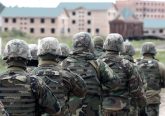
With the military campaign in Afghanistan in the middle of its eleventh year, NATO has firmly moved from what is idealistically desirable to what is realistically achievable in the war-torn country. Over a decade ago, NATO intervened in Afghanistan with post-Cold War ambition. But the experience in Afghanistan, where the battle with Taliban-led insurgents is far from over, has put many off protracted peacekeeping missions. The US, who went into Afghanistan with a neoconservative mission of turning a tribal system upside down, is finally settling for an imperfect yet “responsible end” to a prolonged, unpopular, costly and deadly war.
At the recently-held summit in Chicago, NATO leaders announced an “irreversible” three-stage security transition plan. Under the plan, Afghan National Security Forces (ANSF) will assume full responsibility for combat operations within a year; NATO will withdraw all of its combat troops from Afghanistan by the end of 2014; and the Afghan government will receive some $4 billion in security assistance from the US and its NATO allies, in addition to non-combat military support for a decade beyond 2014.
NATO was already committed to the 2014 withdrawal deadline, a decision reached at the November 2010 summit in Lisbon. But the Chicago summit has not only reaffirmed this decision, it unveiled the specifics of withdrawal timeline and underlined the alliance’s commitment to Afghan security in the post-withdrawal period.
It’s a tall order. The roughly 352,000-strong ANSF will assume combat responsibility of three-forths of Afghanistan by the end of this year and full combat responsibility by the middle of next year, including the traditional Taliban strongholds of Helmand and Kandahar and restive regions to the east. Until the end of 2014, the ANSF is on its own to fight Taliban-led insurgents, with allied forces providing the necessary support — air cover (including drone capability) and command guidance. Ground support is not ruled out either. Beyond 2014, the US and NATO will continue to play a supportive military role. Around 2,000 NATO military advisers and trainers, and some 20,000 US combat ‘enablers’, will remain in Afghanistan for a decade.
The post-2014 presence of US forces in Afghanistan is guaranteed under the Strategic Partnership Agreement (SPA), which the US and Afghan leaders signed on May 2, while marking the first anniversary of the killing of al-Qaeda leader Osama bin Laden. One of the sticking points in the run up to the conclusion of SPA was the Afghan government’s demand that the US-led coalition should formally commit in concrete terms to a multi-billion dollar security assistance package for Afghanistan’s security in the post-withdrawal period. At the December conference on Afghanistan in Bonn, President Karzai had demanded $10 billion dollars a year until 2025 in security and development assistance for Afghanistan. But the recession-hit donor nations, including the US, had then responded “lukewarmly” to the Afghan demand. At the Chicago summit, on the other hand, NATO members agreed to provide close to $4 billion security aid annually to Afghanistan for a decade after 2014, with the US contributing two-third of the amount. A similar global commitment to assist Afghan government’s development efforts beyond 2014 is expected at the international donors’ conference on Afghanistan, to be held in July in Tokyo.
NATO’s exit strategy meets three preliminary preconditions of an Afghan endgame premised on relative stability. First, it entails a commitment the Afghans have long sought from the international community that it will not abandon them as before, following the Soviet exit from Afghanistan over two decades ago. The international summitry process, with pledges made in Chicago and probably additional ones to be announced in Tokyo, essentially guarantees such commitment. As per the second precondition, foreign troops at some stage had to militarily disengage from the war, handing over security responsibility to their Afghan counterparts. The US-led coalition is now committed to this course. Finally, resolution of Afghan conflict through political means requires that foreign troops should leave Afghanistan. The US-led coalition is now committed to the withdrawal option, which means that Taliban-led insurgents will find it increasingly difficult to use the presence of foreign troops on Afghan soil as a pretext to fight and oppose dialogue.

Now that NATO is committed to transfer security responsibility to Afghanistan, withdraw its combat forces from there and commit itself to long-term security of the war-torn country, what remains are steps that the alliance, and America as its lead player, need to take to co-opt Pakistan and other regional states in an Afghan-led and Afghan-owned peace process to secure an ethnically-balanced and all-inclusive political structure in Afghanistan. So far, the US and NATO have preferred to chalk out a course in Afghanistan either on their own or in cooperation with the Afghan government. In pursuing talks with Taliban last year, the US even did not bother to consult the Afghan leadership. Its tussle with Pakistan over the NATO supply route remains unresolved. The Obama Administration unveiled its Af-Pak strategy in March 2009, with a provision to establish a Contact Group of regional and international states on Afghanistan. There is virtually no talk of exercising this crucial option.
NATO’s plan for phased withdrawal may not proceed as planned, if quicker and credible progress is not made in securing the required regional cooperation to amicably resolve a conflict that involves a host of divergent and competitive regional interests. It is irrational to presume that without such political compromise the level of Taliban-led insurgency the US and NATO expect during the time the Afghans assume responsibility for combat operations, or in the run up to the withdrawal deadline of 2014, will be manageable. First, it is debatable whether the poorly-equipped and generally ill-disciplined Afghan security forces will be able to muster the required military resolve to fight Taliban-led insurgents in their strongholds of southern and eastern Afghanistan. Second, with the French forces departing this year and the Australian in the next, the pace of the drawdown process could become panicky enough to trigger widespread desertions in the ANSF. And, amid the worsening situation, each of the NATO states engaged in the Afghan campaign may not prefer to be the last with its troops on the ground, even if the Americans decide otherwise.
What happens beyond 2014 is uncertain. Afghanistan may experience the resumption of a civil war of the sort of 1990s, with regional states supporting their respective sides in a proxy war. This is possible if the recession-hit allied nations see no incentive in fulfilling their financial commitment to Afghan security. This is avoidable, but only if parties can reach a credible regional solution.
Then there is the immediate issue over NATO’s southern supply route through Pakistan, which brought in almost 30 percent of the non-lethal supplies until its closure in November, after an US airstrike killed two-dozen Pakistani soldiers. This route must be reopened to facilitate troop withdrawal. Using the northern supply route will be expensive, passing through Russia (who may not allow it) and must use air cargo, which is incapable of transporting bulky military hardware. In a unanimously passed resolution in April, the Pakistani parliament linked the resumption of NATO supplies with the US issuing an unconditional apology over the incident, stopping its drone campaign in North Waziristan and paying a much higher toll charge for each NATO container using the Pakistani route ($5,000 instead of $250). The Obama administration has refused to apologise and continues the drone campaign.
Pakistan’s demand for higher toll rate is officially justified because of “wear and tear” to its road infrastructure, but it is also, quite obviously, a response to the US refusal to provide $2.5 billion in outstanding Coalition Support Fund (CSF) cash. For long stretches, however, the Pakistani government has proven a workable partner — showing flexibility over drone use — while American and Pakistani officials are sorting out their differences over the pricing issue. Until the start of last year, the countries were committed to a Strategic Dialogue, with the Obama Administration committed to a multi-billion dollar civilian development assistance programme for the country. But since then, their relationship has deteriorated. Neither party can afford this, at a crucial juncture of the Afghan war and with uncertainties lingering over its future course.
Among all other regional players, Pakistan’s role in facilitating NATO’s exit strategy will be most crucial, not just in terms of facilitating the withdrawal process but also in bringing about a viable reconciliation process in Afghanistan. Pakistan’s post-9/11 counter-terrorism conduct may be questionable, but it has a pragmatic interest in securing a peace settlement in Afghanistan that effectively addresses the issue of Pashtun marginalisation. Pakistan has already suffered enough from Taliban terrorism, and the revival of Taliban order out of the possible anarchic circumstances in a post-NATO Afghanistan will only accentuate its security problems.
The author is the Quaid-e-Azam Fellow at St. Antony’s College, Oxford University.







1 Comment